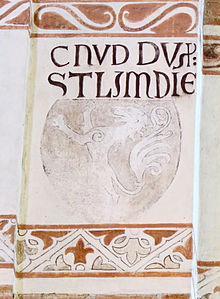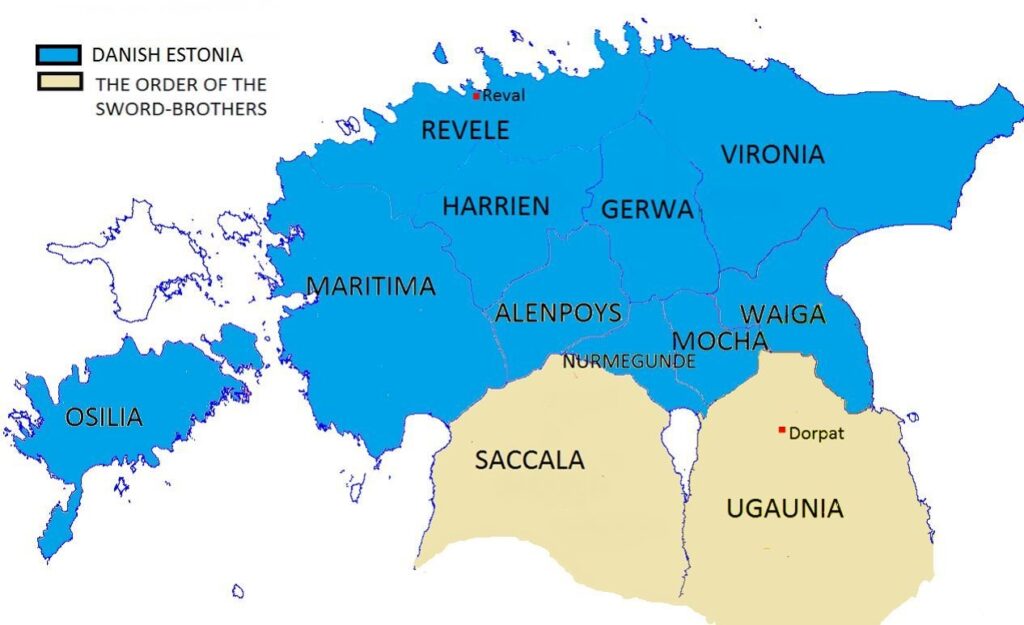By Mihkel Mäesalu and Stefan Pajung
A few months ago we made a post on this blog on how Danish Estonia was called during the 13th and 14th centuries. As our readers and followers know, Duke of Estonia was a title held by the King of Denmark between 1269 and 1346. But there was one Duke of Estonia before that – a person often forgotten by historians.
The first person to hold the title Duke of Estonia was Knud (lived ca 1205–1260), an illegitimate son of king Valdemar II (1202–1241) and a Swedish noblewoman Helena Guttormsdotter, widow of the Danish nobleman Esbern Snare (lived 1127–1204). Knud was probably born in the year 1205 and was in fact the second son of king Valdemar II. Because he and his elder half-brother Niels had been born out of wedlock, they were deemed ineligible to inherit the throne. In all other aspects Valdemar II seems to have treated them equal to his legitimate children with queens Dagmar of Bohemia (1205–1212) and Berengaria of Portugal (1214–1221). He awarded them with parts of the Danish Kingdom to rule. Niels became Count of Halland (1216–1218) and Knud the Duke of Estonia.

Valdemar II began with his crusade and conquest of Estonia in the summer of 1219, he made a second campaign to Northern Estonia in the summer of 1220, and in 1222 he conquered the island of Saaremaa on the western coast of Estonia. During his stay on Saaremaa king Valdemar II managed to resolve his conflict with his rivals in the crusade against Estonia: Bishop Albert of Riga (1199–1229) and the Order of the Swordbrothers. When Valdemar II returned to Denmark in the Autumn of 1222, he had reason to believe Danish lordship over large parts of Estonia secure enough to pass it over to his son. Even though we do not know when Valdemar created the Duchy of Estonia and granted it to his son Knud, it seems probable that he did so at some point between the Autumn of 1222 and May 1223.

There is very little information on Knud’s reign as Duke of Estonia. His rule over Estonia seems to have already been largely forgotten in the 13th century. The only chronicle, which mentions Knud as the Duke of Estonia is “The Chronicle of the Church of Ribe”. When writing of how bishop Tuve of Ribe (1214–1230) spent the winter of 1222–1223 in Tallinn leading missionary work among the native Estonians, the chronicler mentiones, that upon heading back to Denmark in the spring or early summer of 1223, Bishop Tuve left Tallinn in the hands of Duke Knud of Estonia. Therefore, Knud seems to have been in Tallinn in the year 1223. The only act by Knud as Duke of Estonia known to historians is a grant of lands in Northern Estonia to the Cistercian Monastery of Gudvalla (also known as Roma) in Gotland. This grant to the Cistercians of Gotland can be seen as an act of piety by the young Duke, but also as a means to further the Christianization of the native Estonians living under Knud’s rule.
Knud became Duke of Estonia in a time that was very difficult for both the Kingdom of Denmark itself, as well as for the Danish rule in Estonia. Count Heinrich I of Schwerin (1194–1228) took king Valdemar II and his son and co-king Valdemar the Young (1218–1231) captive in May 1223 and held them for a number of years. Valdemar II was released in December 1225, whereas Valdemar the Young was released only at Easter 1226. Already in the winter of 1222–1223, an uprising against Danish rule began on the island of Saaremaa, which quickly spread to mainland Estonia. By spring 1223, only Tallinn was still in the hands of the Danish administration, all other parts of Estonia were once again under native Estonian rule. This situation led the former enemies – the Danes and the Order of the Swordbrothers, the bishop of Riga and the bishop of Tartu– to cooperate in the re-subjugation of Estonia. But this soon led to further conflicts between the Danish administration on one side, and the Swordbrothers and the bishops of Riga and Tartu on the other side. A full-scale war broke out in 1226 and by 1227 the Swordbrothers and the bishops had conquered all Danish possessions in Estonia.
We have absolutely no information of Knud’s involvement in these events. Even though he seems to have been personally in Estonia in the summer of 1223, he may have stayed there for a short while only. Maybe he sailed back to Denmark as soon as he had heard of the capture of his father. We simply do not know. Even though Estonia had been lost, Knud continued to hold the title Duke of Estonia until the year 1232, when his father named him Duke of Blekinge.


